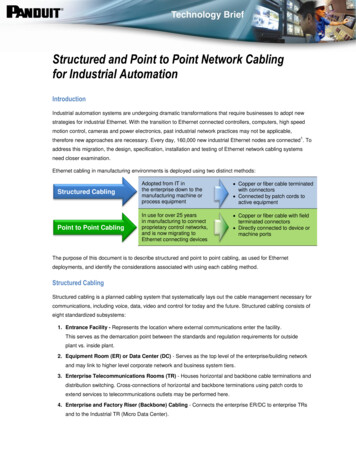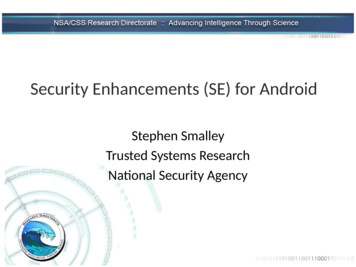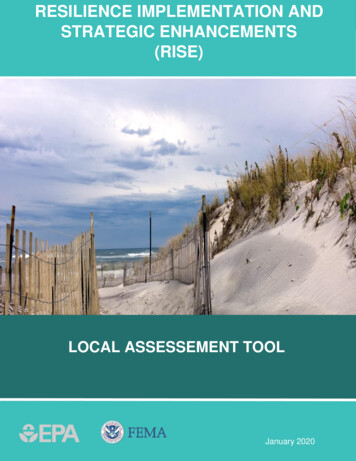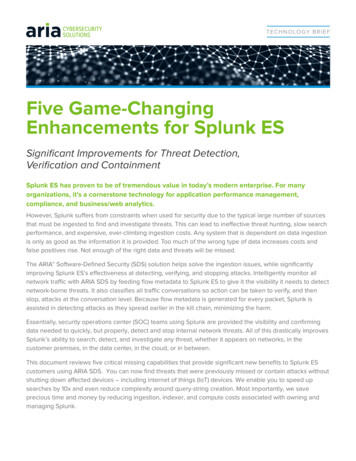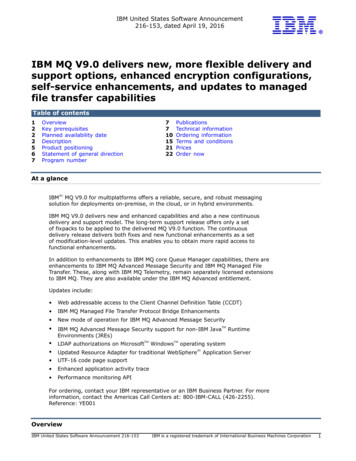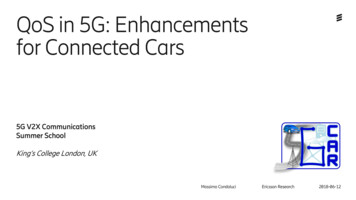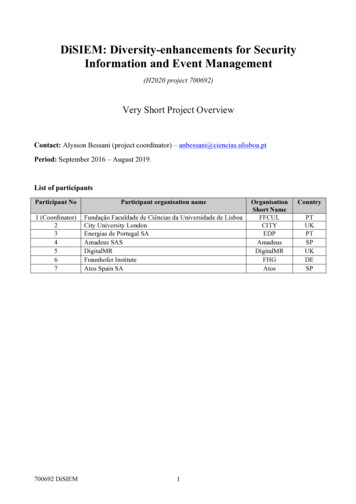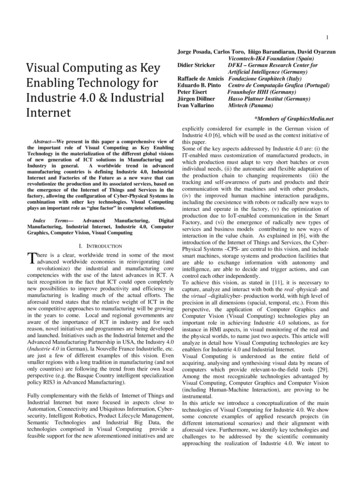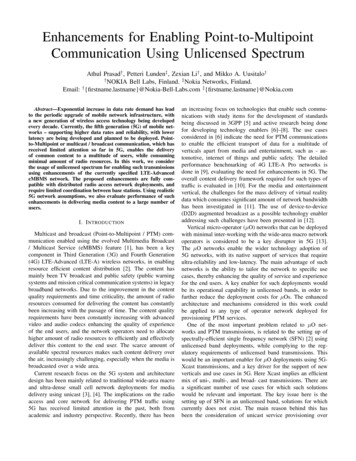
Transcription
Enhancements for Enabling Point-to-MultipointCommunication Using Unlicensed SpectrumAthul Prasad† , Petteri Lunden‡ , Zexian Li† , and Mikko A. Uusitalo††NOKIA Bell Labs, Finland. ‡ Nokia Networks, Finland.Email: † {firstname.lastname}@Nokia-Bell-Labs.com ‡ al increase in data rate demand has leadto the periodic upgrade of mobile network infrastructure, witha new generation of wireless access technology being developedevery decade. Currently, the fifth generation (5G) of mobile networks – supporting higher data rates and reliability, with lowerlatency are being developed and planned to be deployed. Pointto-Multipoint or multicast / broadcast communication, which hasreceived limited attention so far in 5G, enables the deliveryof common content to a multitude of users, while consumingminimal amount of radio resources. In this work, we considerthe usage of unlicensed spectrum for enabling such transmissionsusing enhancements of the currently specified LTE-AdvancedeMBMS network. The proposed enhancements are fully compatible with distributed radio access network deployments, andrequire limited coordination between base stations. Using realistic5G network assumptions, we also evaluate performance of suchenhancements in delivering media content to a large number ofusers.I. I NTRODUCTIONMulticast and broadcast (Point-to-Multipoint / PTM) communication enabled using the evolved Multimedia Broadcast/ Multicast Service (eMBMS) feature [1], has been a keycomponent in Third Generation (3G) and Fourth Generation(4G) LTE-Advanced (LTE-A) wireless networks, in enablingresource efficient content distribution [2]. The content hasmainly been TV broadcast and public safety (public warningsystems and mission critical communication systems) in legacybroadband networks. Due to the improvement in the contentquality requirements and time criticality, the amount of radioresources consumed for delivering the content has constantlybeen increasing with the passage of time. The content qualityrequirements have been constantly increasing with advancedvideo and audio codecs enhancing the quality of experienceof the end users, and the network operators need to allocatehigher amount of radio resources to efficiently and effectivelydeliver this content to the end user. The scarce amount ofavailable spectral resources makes such content delivery overthe air, increasingly challenging, especially when the media isbroadcasted over a wide area.Current research focus on the 5G system and architecturedesign has been mainly related to traditional wide-area macroand ultra-dense small cell network deployments for mediadelivery using unicast [3], [4]. The implications on the radioaccess and core network for delivering PTM traffic using5G has received limited attention in the past, both fromacademic and industry perspective. Recently, there has beenan increasing focus on technologies that enable such communications with study items for the development of standardsbeing discussed in 3GPP [5] and active research being donefor developing technology enablers [6]–[8]. The use casesconsidered in [6] indicate the need for PTM communicationsto enable the efficient transport of data for a multitude ofverticals apart from media and entertainment, such as - automotive, internet of things and public safety. The detailedperformance benchmarking of 4G LTE-A Pro networks isdone in [9], evaluating the need for enhancements in 5G. Theoverall content delivery framework required for such types oftraffic is evaluated in [10]. For the media and entertainmentvertical, the challenges for the mass delivery of virtual realitydata which consumes significant amount of network bandwidthhas been investigated in [11]. The use of device-to-device(D2D) augmented broadcast as a possible technology enableraddressing such challenges have been presented in [12].Vertical micro-operator (µO) networks that can be deployedwith minimal inter-working with the wide-area macro networkoperators is considered to be a key disruptor in 5G [13].The µO networks enable the wider technology adoption of5G networks, with its native support of services that requireultra-reliability and low-latency. The main advantage of suchnetworks is the ability to tailor the network to specific usecases, thereby enhancing the quality of service and experiencefor the end users. A key enabler for such deployments wouldbe its operational capability in unlicensed bands, in order tofurther reduce the deployment costs for µOs. The enhancedarchitecture and mechanisms considered in this work couldbe applied to any type of operator network deployed forprovisioning PTM services.One of the most important problem related to µO networks and PTM transmissions, is related to the setting up ofspectrally-efficient single frequency network (SFN) [2] usingunlicensed band deployments, while complying to the regulatory requirements of unlicensed band transmissions. Thiswould be an important enabler for µO deployments using 5GXcast transmissions, and a key driver for the support of newverticals and use cases in 5G. Here Xcast implies an efficientmix of uni-, multi-, and broad- cast transmissions. There area significant number of use cases for which such solutionswould be relevant and important. The key issue here is thesetting up of SFN in an unlicensed band, solutions for whichcurrently does not exist. The main reason behind this hasbeen the consideration of unicast service provisioning over
SFN AreaEnhance SYNC protocol forunlicensed band operationXnM1*Enable transmission coordinationusing MCE enhancements withsub-optimal network operationMBMS-GWM2*MCEFig. 1. Channel access for listen-before-talk.M3*MMEBMSCSm *ContentProviderunlicensed bands.Unicast transmissions using unlicensed band has receivedsignificant attention in the context of 4G networks. LTEoperation using unlicensed spectrum with license-assisted access (LAA) feature which augments the capacity of existingdeployments using licensed spectrum has been studied in [14].The co-existence of LTE and WiFi, especially with the usageof Multefire standalone unlicensed network deployments havebeen considered in [15]. In order to obtain the significantamount of bandwidth required for 5G networks, they needto natively support unlicensed band operation [16]. Hence,the future releases of the standards are expected to supportstandalone operation using unlicensed frequency bands.The challenge in operating SFN on unlicensed spectrumis that due to the listen-before-talk (LBT) mode of operationrequired by the regulations [17]: 1) the access to the mediumcannot be guaranteed at any specific moment, and 2) even theother transmitters of the same network (SFN) block the accessto the channel. Another key challenge is that the transmitpower is limited on unlicensed spectrum leading to smaller cellsize. Thus, there are potentially a large number of neighborcells competing for the same channel, which is an issue whenthey all try to transmit at the same time (as in SFN) but stillneed to apply LBT. These challenges make it non-trivial toenable SFNs on unlicensed spectrum. While some countriesthe regulation does not enforce listen before talk, it would bechallenging to enable large scale deployments that would notfollow such an operational paradigm.The rest of the paper is structured as follows: Section IIprovides an overview of the system model used, Section IIIdiscusses the key challenges for indoor VR broadcast. Section IV presents the simulation assumptions and system levelparameters used for simulations, together with performanceresults of the proposed scheme. Section V gives summary ofthe paper.II. S YSTEM M ODELIn this work, we consider a system operating using unlicensed frequency bands, constrained by listen-before-talk with each base station listening for channel occupancy beforetransmitting data and occupying the channel, similar to theone considered in [18]. The channel access mechanism usedby two 5G base stations (gNBs) is as shown in Fig. 1. Dueto the limited transmit power of such a system, we considersmall cell network deployments, with the user equipment (UE)connected to the network for its communication needs. It isFig. 2. System considered in this work.Frame Type-0(a) Use Frame Type-0 for channel sensing timeinstances/subframes, other types for transmissionsSpareTime Stamp(b) Indicate Transmission Type– Transmit / Channel SensingPacket CounterElapsed Octet CounterControl PartTotal No. Of PacketFrame Type-2Total No. Of OctetTime StampCRCPaddingFrame Type-1SpareChecksum PartSparePacket CounterElapsed Octet CounterControl PartTotal No. Of PacketTime StampTotal No. Of OctetPacket CounterElapsed Octet CounterControl PartCRCPaddingChecksum PartPayload CRCTotal No. Of PacketPayloadPayload PartTotal No. Of OctetCRCPaddingPayloadCheck sum PartPayload Part(c) Use null-payload to configuresensing time instancesFig. 3. Possible SYNC protocol enhancement options.assumed that all the UEs request common data which is thendelivered by the network using over-the-air broadcast.For the sake of simplicity, we assume the LTE-A eMBMS network architecture shown in Fig. 2 for delivering thebroadcast traffic, with enhancements to enable SFNs usingunlicensed bands. The enhancements are mainly proposed onthe synchronization protocol (SYNC) [19], which limits theimpact on the radio access and core network entities. Herethe multi-cell coordination entity (MCE) which configuresand coordinates the radio transmission parameters within theRAN would also require enhancements, especially for the casewhen the channel is occupied by other transmitters. While themechanisms described in this work are mainly from LTE-AeMBMS perspective, the solution is applicable to any multicast/ broadcast capable network, which supports a central networkentity for providing the timing for synchronized over-the-airtransmissions.III. U NLICENSED M ULTICAST / B ROADCASTIn this work, we consider the setup SFN transmissions withthe help of SYNC protocol [19] enhancements in the Broadcast Multicast Service Center (BMSC), which translates theincoming data packets into SYNC protocol data unit (PDUs).The timestamp information in the SYNC PDUs enable allthe BSs which are part of the SFN area to schedule the
Channel BusyChannel SensingSYNC PDUsChannel OccupiedChannel SensingData transmissionSYNC PDUsgNB-1SFNgNB-2gNB-3gNB-4SFN AreaUnicastTransmission AreaXn5G-gNB-25G-gNB-3XnXn5G-gNB-45G-gNB-1Fig. 4. Overview of the network for unlicensed Xcasting with completeinterference coupling.Channel BusyChannel SensingSYNC PDUsChannel OccupiedChannel SensingData transmissionSYNC PDUsgNB-{1-3} engage inSFN transmissions afterdetecting free channelgNB-1SFNgNB-2gNB-3gNB-3 drops the transmissionpackets and remains idlegNB-4 is still occupying thechannel / interfering gNB-3UnicastTransmission AreaSFN AreaXn5G-gNB-25G-gNB-35G-gNB-4XnXn5G-gNB-1Fig. 5. Unlicensed Xcast network operation with partial interference.multicast / broadcast transmissions in a synchronized manner.The enhancements enables the BMSC to inform the basestation (BS) about the transmit time instances / subframes andthe channel sensing time instances in a synchronized manner.The SYNC enhancements enables the network deployed onan unlicensed band to comply with the regulatory restrictionsimposed by listen-before-talk form of communication. The BSbased on the information contained in the SYNC PDUs, coulddetermine the occasions for synchronized channel sensing anddata transmissions. During the channel sensing time instances,if the BS detects the channel to be busy, then it drops the SFNFig. 6. Channel access for listen-before-talk with partial interference.packets and remains idle during the data transmission timeinstances. In this work, LTE-A is used as a baseline sincethe current 5G architecture [20] has been designed only forunicast.Various options for SYNC protocol enhancements are asshown in Fig. 3, based on the various PDU types currentlydefined [21]. Here we consider three possible alternatives – a)The usage of frame type-0 for channel sensing time instancesor subframes and possibly for other types of transmissions (occupied / busy), b) Use the spare bits within the different frametypes to indicate the action to be taken during each subframeor time instances, c) Use the null payload within frame type-1and 2 for configuring the channel sensing time instances. Theuse of SYNC enables the distributed deployment of BSs withinthe network and avoids the need for low-latency interfaces inorder to coordinate the BS transmissions.The operation of the proposed mechanism is as shownin Fig. 4, with 5G-gNBs-(1 3) forming an SFN area,whereas 5G-gNB-4 operates independently having its ownset of unicast transmissions. The 5G-gNB-4 is assumed tohave significant interference coupling with 5G-gNBs-(1 3),thereby limiting SFN transmissions on time instances when5G-gNB-4 occupies the unlicensed band. Here the key idea isthat the gNBs-(1 3) would be coordinating its transmissionsand channel sensing opportunities, while ignoring possiblebusy indications from gNBs which are part of the SFN area,since that would be the desired mode of operation. The information related to coordinating gNBs / base stations could beprovided by the BMSC using the SYNC PDUs with the MCEmaking appropriate configurations in the RAN, for setting upthe SFN service flow sessions. The coordination informationcould be related to the absolute time instances where suchtransmissions are expected to be sent, based on the timestampsin the SYNC PDU. Here the information could also includethe subframes / radio frames where such transmissions areexpected after sensing the channel to be free and acquiring thechannel. The key scenario considered here is that the gNB-4is essentially interfering with all the SFN gNBs - (1-3). Whenthere is no interference from the neighboring access points(which are not part of the SFN), the MCE configures regularradio transmission parameters in order to ensure coverage andcapacity within the SFN area.The system behavior for the partial interference couplingcase is as shown in Fig. 5. Here the unicast gNB-4 hasinterference coupling only with gNB-3, which is part ofthe SFN network together with 5G-gNBs-(1 2). Here thebehavior would be that gNB-3 would simply drop the packetsmeant for transmission, upon sensing that the channel isbusy for time instances or subframes where the SYNC PDUsare meant to be transmitted. The gNB-3 would also signalto the MCE (potentially using the interface M2-applicationprotocol (AP) enhancements) about the inactivity during theupcoming data-transmit time instance. MCE upon receivingthis message would adapt the radio transmission parameters ofthe remaining active base stations for the current transmissiontime instance, in order to ensure coverage and capacity, with
possible spectrum scaling. Normal procedure resumes duringsubsequent time instances, when the gNBs within the SFNarea engage in channel sensing based on the configurationsfrom the BMSC and start transmitting after receiving suchconfigurations in a synchronized manner. Here, if all the basestations detect the channel to be busy, the data transmit PDUsare buffered until the next transmission instance. Anotherboundary condition for this action could be if the number ofbase stations unable to transmit are above a certain threshold,then the base stations could skip the current transmissioninstance and buffer the data until the next transmission instance. It is assumed that proper cell planning and appropriateisolation in the data transmission areas could prevent such anevent from occurring. The network could also have a roughcoverage map(s) for different base stations, based on whichit can determine if the blocking is affecting the coveragesubstantially or not. Condition could then be whether thereare areas where the combination of transmitting base stationsis not providing sufficient coverage.UE measurements are an integral part of such technologyenablers for 5G. From an UE perspective, the gNBs shouldconfigure the UEs to report interference / reference signalingreceived power (RSRP) measurement reports from only thosegNBs / access points (APs) that are not part of the SFNtransmissions. This could essentially mean that if the UEmeasures another gNB / cell whose ID is not part of aconfigured list, and the measured energy/power levels areabove a threshold, the UEs would send measurement reportsaccordingly. Thus, the coordinating gNBs / base stations partof the SFN service flow session should configure UEs withnew RRC measurement configuration to send measurementreports only when transmissions are detected from gNBs / basestations / access points which are not part of the SFN serviceflow session. With the help of explicit gNB / base stations cell/ beam IDs along with the signal strength configurations formeasurement reporting, the UEs can optimize the amount offeedback that is required to be sent without additional explicitconfigurations. Here the UEs would also be configured toconduct measurements only during those time instances whereSFN service flow transmissions are expected. This wouldenable true-XCast scenarios where the gNBs could switchseamlessly between uni-, multi- or broad-cast.Such a scenario where the gNBs engage in non-SFN transmissions at particular time instances are as shown in Fig. 6.The coordination between gNBs for channel sensing, includingpossible exchange of such measurement information betweengNBs using new information elements defined over the Xninterface. Since beam-based system is one of the key designelements of 5G, the mechanism could also be applied on suchscenarios, where the coordination needs to be done at a beamlevel rather than the cell level.IV. S IMULATION R ESULTSA. Simulation AssumptionsOne of the key questions about the mechanisms is its effectiveness, considering the fact that some neighboring accessTABLE IS YSTEM L EVEL S IMULATION PARAMETERSBasic Radio Configuration ParametersSmall Cell DeploymentRandom, NSC 5Shadowing Standard DeviationSmall Cell: 3 dBCarrier Frequency60 GHzSmall Cell Max Tx Power [dBm]30Antenna Gain [dB]Small Cell 5UE Tx Power [dBm]21Other Simulation ParametersSpectral Efficiency, Seff4.0No. of RBs, NRB5000PRB size, RBs180 kHzBandwidth Efficiency, Beff0.65SINR Efficiency, SIN Reff0.95User PlacementRandom, NU E 600TrafficFull BufferIndoor VR ver the air deliveryusing broadcastSFN-gNBSFN-gNBFig. 7. Scenario used for simulations.points operating in the unlicensed frequency bands can causeinterference and essentially block the channel. We provideinitial performance results in terms of the impact on userthroughput while operating an SFN in unlicensed spectrum.We consider a small cell network that is assumed to operatein 60 GHz unlicensed frequency band, with 1 GHz of systembandwidth. An SFN area consisting of up to 5 BSs deployed inan indoor 80 m x 60 m area is considered where, 0-2 BSs areinactive due to LBT requirements due to an interfering BS inproximity. The system level parameters used for simulation areas shown in Table I, based on the values and assumptions usedin [11]. The base stations and UEs are assumed to be droppedrandomly within the simulated indoor area, with UEs receivingbroadcast traffic from the active BSs within the SFN area.The UEs are assumed to remain static during each simulationdrop and a new location assigned during the next drop, withsufficiently large number of drops used to obtained sufficientlyrandomized results.The signal-to-interference-noise ratio (SINR) and throughput values are shown for individual users, with the multicast/ broadcast network assumed to be optimized for the radioconditions of the worst user. Here the worst user is considered,as compared to 95th percentile value used for wide-areamultic
Enhancements for Enabling Point-to-Multipoint Communication Using Unlicensed Spectrum Athul Prasad y, Petteri Lundenz, Zexian Li , and Mikko A. Uusitalo yNOKIA Bell Labs, Finland. zNokia Networks, Finland. Email: y{firstname.lastname}@Nokia-Bell-Labs.com z{firstname.lastname}@Nokia.com A
